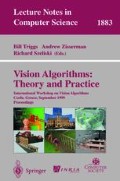Abstract
The prevailing efforts to study the standard formulation of motion and structure recovery have been recently focused on issues of sensitivity and robustness of existing techniques. While many cogent observations have been made and verified experimentally, many statements do not hold in general settings and make a comparison of existing techniques difficult. With an ultimate goal of clarifying these issues we study the main aspects of the problem: the choice of objective functions, optimization techniques and the sensitivity and robustness issues in the presence of noise.
We clearly reveal the relationship among different objective functions, such as “(normalized) epipolar constraints”, “reprojection error” or “triangulation”, which can all be be unified in a new “ optimal triangulation” procedure formulated as a constrained optimization problem. Regardless of various choices of the objective function, the optimization problems all inherit the same unknown parameter space, the so called “essential manifold”, making the new optimization techniques on Riemanian manifolds directly applicable.
Using these analytical results we provide a clear account of sensitivity and robustness of the proposed linear and nonlinear optimization techniques and study the analytical and practical equivalence of different objective functions. The geometric characterization of critical points of a function defined on essential manifold and the simulation results clarify the difference between the effect of bas relief ambiguity and other types of local minima leading to a consistent interpretations of simulation results over large range of signal-to-noise ratio and variety of configurations.
This work is supported by ARO under the MURI grant AAH04-96-1-0341
Access this chapter
Tax calculation will be finalised at checkout
Purchases are for personal use only
Preview
Unable to display preview. Download preview PDF.
References
K. Danilidis. Visual Navigation, chapter ”Understanding Noise Sensitivity in Structure from Motion”. Lawrence Erlbaum Associates, 1997.
K. Danilidis and H.-H. Nagel. Analytical results on error sensitivity of motion estimation from two views. Image and Vision Computing, 8:297–303, 1990.
A. Edelman, T. Arias, and S. T. Smith. The geometry of algorithms with orthogonality constraints. SIAM J. Matrix Analysis Applications, to appear.
R. Hartley and P. Sturm. Triangulation. Computer Vision and Image Understanding, 68(2):146–57, 1997.
B. Horn. Relative orientation. International Journal of Computer Vision, 4:59–78, 1990.
A. D. Jepson and D. J. Heeger. Linear subspace methods for recovering translation direction. Spatial Vision in Humans and Robots, Cambridge Univ. Press, pages 39–62, 1993.
K. Kanatani. Geometric Computation for Machine Vision. Oxford Science Publications, 1993.
J. Košecká, Y. Ma, and S. Sastry. Optimization criteria, sensitivity and robustness of motion and structure estimation. In Vision Algorithms Workshop, ICCV, pages 9–16, 1999.
H. C. Longuet-Higgins. A computer algorithm for reconstructing a scene from two projections. Nature, 293:133–135, 1981.
Y. Ma, J. Košecká, and S. Sastry. A mathematical theory of camera self-calibration. Electronic Research Laboratory Memorandum, UC Berkeley, UCB/ERL M98/64, October 1998.
Y. Ma, J. Košecká, and S. Sastry. Motion recovery from image sequences: Discrete viewpoint vs. differential viewpoint. In Proceeding of European Conference on Computer Vision, Volume II, (also Electronic Research Laboratory Memorandum M98/11, UC Berkeley), pages 337–53, 1998.
Y. Ma, J. Košecká, and S. Sastry. Linear differential algorithm for motion recovery: A geometric approach. Submitted to IJCV, 1999.
Y. Ma, J. Košecká, and S. Sastry. Optimization criteria and geometric algorithms for motion and structure estimation. submitted to IJCV, 1999.
S. Maybank. Theory of Reconstruction from Image Motion. Springer-Verlag, 1993.
J. Milnor. Morse Theory. Annals of Mathematics Studies no. 51. Princeton University Press, 1969.
R. M. Murray, Z. Li, and S. S. Sastry. A Mathematical Introduction to Robotic Manipulation. CRC press Inc., 1994.
S. Soatto and R. Brockett. Optimal and suboptimal structure from motion. Proceedings of International Conference on Computer Vision, to appear.
M. Spetsakis. Models of statistical visual motion estimation. CVIPG: Image Understanding, 60(3):300–312, November 1994.
T. Y. Tian, C. Tomasi, and D. Heeger. Comparison of approaches to egomotion computation. In CVPR, 1996.
J. Weng, T.S. Huang, and N. Ahuja. Motion and structure from two perspective views: Algorithms, error analysis, and error estimation. IEEE Transactions on Pattern Analysis and Machine Intelligence, 11(5):451–475, 1989.
J. Weng, T.S. Huang, and N. Ahuja. Motion and Structure from Image Sequences. Springer Verlag, 1993.
J. Weng, T.S. Huang, and N. Ahuja. Optimal motion and structure estimation. IEEE Transactions on Pattern Analysis and Machine Intelligence, 15(9):864–884, 1993.
Z. Zhang. Understanding the relationship between the optimization criteria in two-view motion analysis. In Proceeding of International Conference on Computer Vision, pages 772–777, Bombay, India, 1998.
Author information
Authors and Affiliations
Editor information
Editors and Affiliations
Rights and permissions
Copyright information
© 2000 Springer-Verlag Berlin Heidelberg
About this paper
Cite this paper
Košecká, J., Ma, Y., Sastry, S. (2000). Optimization Criteria, Sensitivity and Robustness of Motion and Structure Estimation. In: Triggs, B., Zisserman, A., Szeliski, R. (eds) Vision Algorithms: Theory and Practice. IWVA 1999. Lecture Notes in Computer Science, vol 1883. Springer, Berlin, Heidelberg. https://doi.org/10.1007/3-540-44480-7_11
Download citation
DOI: https://doi.org/10.1007/3-540-44480-7_11
Published:
Publisher Name: Springer, Berlin, Heidelberg
Print ISBN: 978-3-540-67973-8
Online ISBN: 978-3-540-44480-0
eBook Packages: Springer Book Archive

